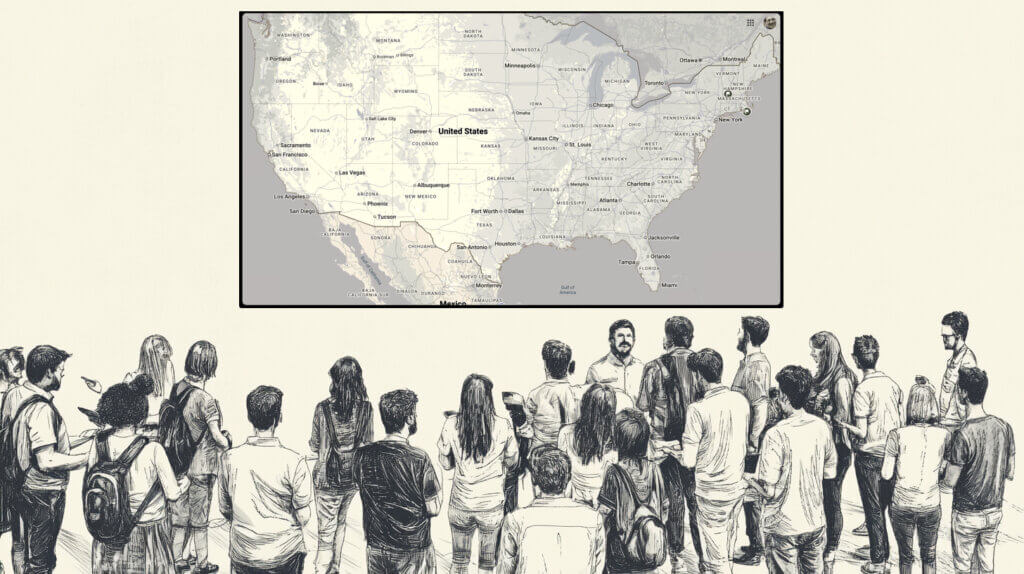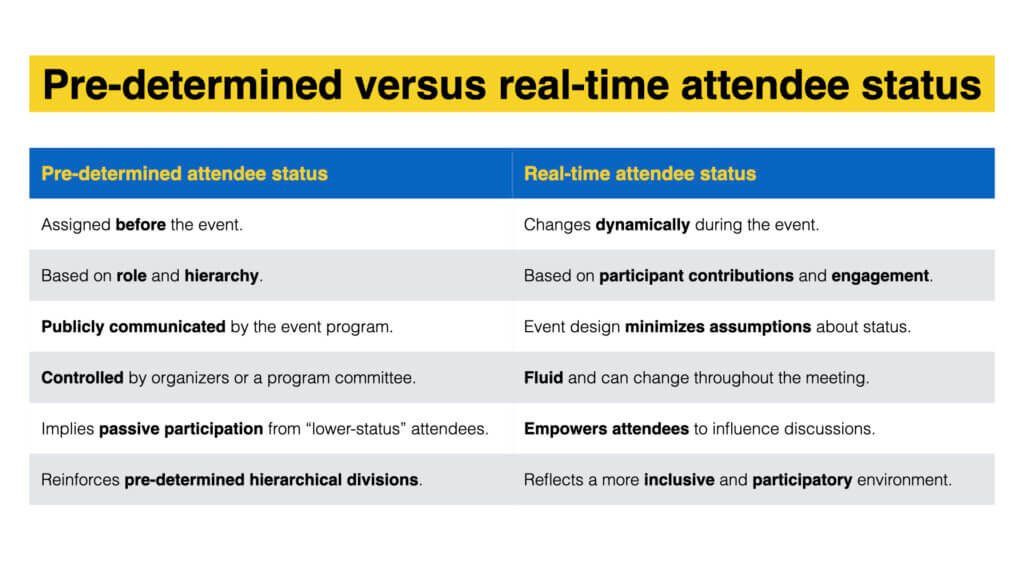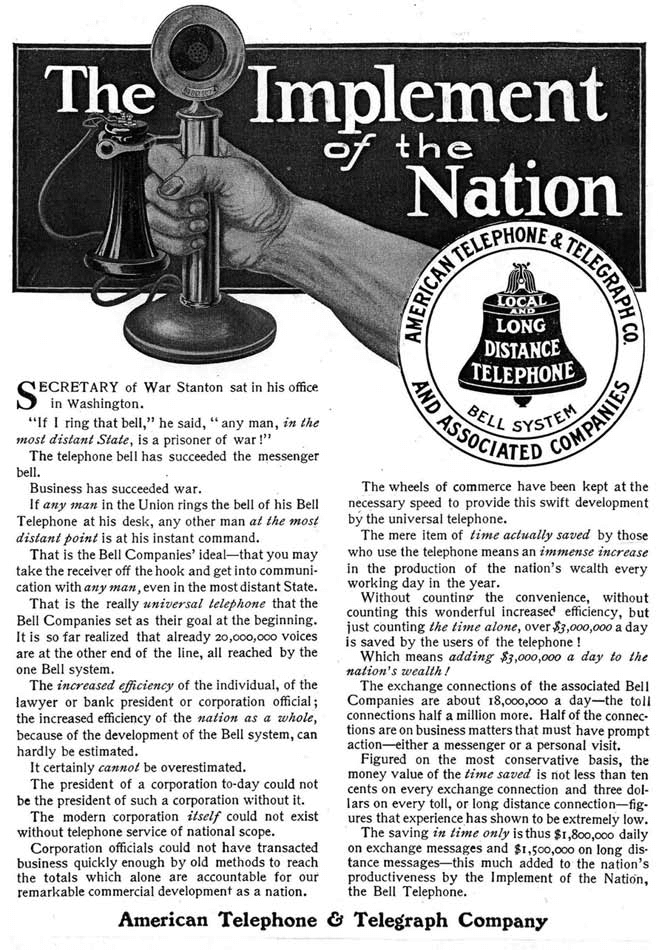The Right Place: Three Encounters with Strangers in Crisis

Read the rest of this entry »

Read the rest of this entry »

Read the rest of this entry »
I love the folks (especially my good friend, Jan-Jaap In der Maur) at Masters In Moderation, a company that has been providing meeting and facilitation services and training in the European Union since 2012. Why? Because their core beliefs about what truly matters at events are deeply aligned with mine. We recognize that events should be designed for and with participants rather than imposed upon them. We understand that engagement is not a gimmick but a fundamental right of every attendee. In short, we believe that participants have rights.
Too often, conferences default to passive experiences—attendees sit, listen, and leave without feeling seen, heard, or meaningfully involved. But Masters In Moderation and I reject this outdated model. Our work champions interactive, participant-driven approaches that transform meetings from stale information dumps into vibrant, co-created experiences.
Jan-Jaap has eloquently outlined these principles in The Participants’ Bill of Rights, a manifesto that articulates what every attendee deserves from an event. It’s a call to action for organizers, facilitators, and speakers to respect, empower, and prioritize the people in the room.
Some highlights that particularly resonate with me:
Jan-Jaap provides many more important details about participants’ rights in this Bill, which is well worth a careful read. As an event participant, how many of these rights do you find you have at events? If you’re convening events, how many of these rights do you give to your attendees?
In my decades of experience designing conferences, I’ve seen firsthand how adopting these principles elevates events. When participants feel valued and engaged, they don’t just attend an event—they co-create it. When event conveners design and facilitate events honoring these principles, the result is a richer, more dynamic, more impactful, and ultimately better experience for everyone involved.
Jan-Jaap and Masters In Moderation are doing essential work to reshape meetings for the better. If you’re serious about making your events truly participatory and improving them for everyone involved, I highly recommend exploring their approach—and taking The Participants’ Bill of Rights to heart.

Don’t do that! More importantly, be suspicious of any non-profit that doesn’t file timely tax returns. When associations ask me to work with them, one of the first things I do is to check out their 990 tax returns on Candid‘s Guidestar, the IRS, or ProPublica. 990s provide a wealth of useful information about tax-exempt organizations. The majority of non-profits file their returns on time, with the 990 typically appearing on the above sites within one to two (at most) years.
A red flag goes up when I discover two or more missing 990s. Why? Because I know only three reasons why 990s aren’t posted in a timely fashion:
1. New non-profits sometimes take a while to realize they need to file 990s, or they struggle to provide the information their accountant needs to file. (Yes, I’ve seen this happen!) Regardless, if you’re working with a new organization, you may want to be cautious.
2. Occasionally, tax preparers for non-profits are behind on their work and file late or request a six-month extension. Again, this can be a warning sign that not all is well.
3. The non-profit is up to no good. When I see several years of returns missing, alarm bells go off. A textbook example of this occurred in 2020. Within 30 minutes of hearing that a non-profit had purchased a college campus in my hometown, a quick check using Guidestar made it obvious that the organization had an opaque financial past. When I confronted the CEO about his non-profit’s missing tax returns, he repeatedly changed the subject. The campus trustees ignored my warnings. It was only after a year of costly mayhem that the FBI arrested the CEO for stealing money from another non-profit to buy the campus! He subsequently went to prison. Here’s the whole sordid story.
Unfortunately, the IRS does a terrible job reviewing and acting on nonprofit filings or non-filings. The IRS can charge penalties for late filings, but, as far as I know, it rarely does. Tax-exempt organizations have to fail to file a 990 for 3 consecutive years before their non-profit status is revoked. And it’s easy for delinquent organizations to get their tax-exempt status reinstated.
So don’t rely on the IRS to police shady nonprofits effectively. (Exhibit A: The Donald J. Trump Foundation.)
And don’t raise suspicions about your non-profit’s finances and activities. File your 990s on time!
Don’t do that! Sometimes, association leadership loses its way. This happens when leadership creates an association whose commitment to membership becomes secondary to leaders’ focus on pursuing profit (and, possibly, their own consequently generous salaries).
As associations grow, it becomes easier for leadership to forget that organizations and associations are, at their core, a set of agreements in people’s minds about supporting a community that is important to them.
“…organizations exist only in the mind; they are no more than the conceptual embodiments of the ancient idea of community.”
—Dee Hock, the first CEO of VISA, Birth of The Chaordic Age
Here’s how one critic describes what happens when association leadership loses its way [see this link for their detailed critique of a specific association]:
“…instead of being an organisation that exists to promote [X] and help their members, the members are rather regarded as nothing but a source of income, which is then stashed away in investments.”
Unfortunately, there’s no pass/fail test to determine whether association leadership has lost its way. So, I’ve seen associations slowly demote supporting their members to a secondary goal over time, though sometimes this happens abruptly with a change in leadership. Members drift away, and the association may go out of business as it becomes increasingly unresponsive to members’ wants and needs.
There’s no simple prophylactic for this problem. But here are three things that every association should do:
1. Hold regular leadership reviews, informed by member input, of the association’s mission. Assess whether the current mission is still 100% relevant and change it when necessary. Then review, revise, and internalize your association’s strategic goals.
2. Follow up with an honest assessment of how well the association’s current actions align with fulfilling its mission.
3. Make the necessary structural and program changes to reduce or eliminate any lack of congruence uncovered in the previous step.
This is hard, and the work never ends. But remember, the core work of an association is to serve its members. Tempted to stray? Don’t do that!
Don’t do that! Just about every association hires consultants. By “consultant” I mean independent professionals and companies that provide organization services, e.g., accountants, attorneys, event planners, etc.
The problem with hiring external expertise is that if you need help, obviously, you lack crucial knowledge or experience. So when you seek help, you don’t know if someone who claims to be able to help really can!
The familiar approach to hiring a consultant is to ask for references. Asking for references is helpful, as long as you take the time to check the references you receive! I’m happy to provide references and am amused at how infrequently they are subsequently checked. Sometimes, a consultant’s references will tell you things that cause you to promptly strike them from your list of candidates.
But there’s another test that you should always apply when hiring a consultant.
Check to see if they will say they don’t know the answer to a question when they actually don’t.
Interview the consultant and ask them questions about the work you want them to do. Listen carefully to how they respond to your questions. You are looking for them to show that they know the limits of their abilities and that they are willing to share their limits with you.
If necessary, ask whether they can do something that is a little outside their stated expertise and listen carefully to how they respond. If you hear an unwillingness to admit that they can’t fulfill your request, you are receiving an important warning. Ignore it at your peril!
Are you thinking of hiring a consultant who won’t sometimes tell you “I don’t know”? Don’t do that!
These three less-common mistakes are ones I’ve encountered repeatedly, yet they often go unnoticed, even by experienced association professionals. I hope that my observations are helpful, and I welcome your thoughts below!
In Part 2 of this post, I share more “Don’t do that!” warnings about common mistakes I’ve seen when planning association events.
[I wrote “Associations: don’t do that! [Part 1]” for Association Chat Magazine, Volume 2, Issue 1, February 2025, and have posted it here with additional links to resources.]
We all need a break sometimes. Since November 2009, I’ve been writing weekly about meeting design, facilitation, and all kinds of other things that have sparked my interest, and I’m taking a break for a couple of weeks. Don’t worry; I’m hanging out here right now.
I’ll be back!
Have a great day!
-Adrian-

It’s easy for me to see aspects of my life as mundane. When I do, I gloss over the present moment, and the personal stories that surround it. Rosemerry prompts me not to:
‘And if, as I now know, the closet
is sacred and the bare room
is sacred and the sidewalk
and classroom and the ER
are sacred, then I trip
into the teaching
that everywhere is sacred—
not only the church, but
the alley. Not only the mosque,
but the bench…’
—The beginning of the poem Sacred Ground by Rosemerry Wahtola Trommer
Reading the poem, I was reminded that approaching mindfulness as the cultivation of embodied awareness includes “having my heart be where my feet are.”
At times, this feels so dificult. I distract myself from being present. I fret over why things are the way they are instead of accepting or changing them. And I get lost in the mundane.
The poem’s end offers a redemptive practice…
‘…Every step, a step
from holy to holy
to holy.’
Thank you, Narayan Helen Liebenson, for introducing me to Rosemerry’s poem.
Image attribution: Timothy Neesam (GumshoePhotos) under a CC BY-NC-ND 2.0 license
Aside from my first book, I haven’t written much about the effects of attendee status — attendees’ “relative rank in a hierarchy of prestige” — at events. It’s time to revisit this important topic because you can improve your meetings by making attendee status a real-time construct.
Traditional, broadcast-style events assign attendee status in advance. A person’s status is determined before the event by whether they’re speaking and the context. For example, keynoting is of higher status than leading a breakout session. The program committee bestows status on certain attendees. Their status is publicly proclaimed on the pre-conference program, giving attendees no say in the decision.
At peer conferences (and some traditional events), attendee status is dynamic, shifting from moment to moment. Here’s how pre-determined and real-time attendee status compare:

With careful design, even traditional events can minimize assumptions about attendee status.
Read the rest of this entry »

Dealing with powerful assholes (PAs) who are affecting many lives through societal manipulations requires some different approaches.
First, though, here’s a reminder of how to deal with assholes in your personal life:
“The best way to deal with assholes is to avoid them whenever possible. If you can’t, then don’t confront them; they love that. Instead, ignore them. If you have to interact with one, set boundaries on the time you’ll be with them and what you will tolerate. This can be tough, so remember that their assholeness is their problem, not yours.
Remember that assholes are not happy people. Though it’s hard to do, if you can feel compassion for an asshole you’re with, it will help you deal with their behavior better. And it may (don’t count on it) help them be slightly less asshole-like with you.”
—Adrian Segar, Assholes, potholes, and black holes, May, 2023
When dealing with PAs, most of the above advice is still relevant.
Ignoring PAs is important when they are trying to get reactions from those they are trying to vilify or rile up. Assholes are cruel, sick people who enjoy seeing others suffer. By not responding emotionally when they spout theatrical nonsense or lies, you avoid buying into their attempts to make you suffer. Yes, this can be hard to do. Reminding yourself that their assholeness is their problem, not yours, can help.
Since his inauguration, the 47th U.S. President [47] — a quintessential PA — has been issuing a torrent of Executive Orders (EOs) that are an archetypal embodiment of PA cruelty. Under such a constant bombardment, it’s hard to remember that many of his EOs are meaningless or illegal. Each EO is designed to elicit a nasty emotional effect on those who are disgusted with this man, but much of what he says has little or no connection with what he does. I am not minimizing the very real damage 47 is inflicting on individuals, the United States, and the world. Rather, I’m saying that we need to tune out the performative cruel statements of PAs and focus on combatting and resisting the very real destruction they cause (see below).
Read the rest of this entry »

Professional, cultural, and social online communities are at risk. Xitter is in the final stages of enshittification. Facebook is inundated with advertisements and extensive data mining practices. LinkedIn groups’ algorithms bury most comments and reduce the visibility of posts with links. While private groups on major platforms remain functional, opaque and ever-changing algorithms control what users see, and the future viability of these groups is uncertain.
In addition, all corporate platforms are vulnerable to changes imposed by the owners, who can sell them at any time to new proprietors with different visions for operation or monetization, potentially further compromising the user experience.
Read the rest of this entry »
Event planners often overlook the importance of attendee conversations. Why does this happen?
For a clue, read this AT&T advertisement promoting telephones in the 1900’s!

Here’s Kevin Kelly’s analysis of what AT&T totally missed about how telephones could be used.
“Advertisements at the beginning of the last century tried to sell hesitant consumers, the newfangled telephone by stressing ways it could send messages, such as invitations, store orders, or confirmation of their safe arrival. The advertisers pitched the telephone as if it were a more convenient telegraph. None of them suggested having a conversation.“
—Kevin Kelly, “What Technology Wants” (p. 245)
Early telephone ads marketed it as a better telegraph. They focused on the value of sending messages rather than fostering conversation.
So, perhaps it’s not surprising that many conference organizers today make a similar mistake by emphasizing broadcast content over attendee interactions.
Just as advertisers missed the phone’s potential to connect people in real-time, many events fail to prioritize the natural value of attendee conversations. When organizers structure conferences as one-way content delivery sessions, they overlook the simple, high-impact power of peer-to-peer dialogue. By designing events that actively support and facilitate attendee conversations, conferences become spaces of meaningful connection, creativity, and insight that go far beyond passive listening.
Event planners must shift their mindset to seeing attendees as active participants, not just an audience. Facilitating genuine exchanges can turn an ordinary event into a transformative experience, helping people connect, share ideas, and solve problems together—things that no amount of broadcast content alone can achieve.